A Solved Problem 4-9 For available compressive strength.
A Solved problem 4-9 for critical stress for a given W-section.
We are continuing With the strength-solved problems for compression members and how to use tables to get the value for LRFD and ASD.
Now with a new solved problem that is solved problem 4-9 from Prof Segui’s handbook. We have a W12x 58, height is 24 feet long, is pinned at both ends and braced in the weak direction at the third point, in the x-direction, the column is braced at the top and bottom, hence k=1. The y-direction is bracing at the third point, which means bracing for one-third of the column for each length is 8 feet.


We have two points, the aim purpose of this solved problem is to make k*L/r in the x-direction the main criteria for evaluating the buckling load, and it is sometimes the x-direction slenderness ratio may control the strength by controlling the bracing in the y-direction of the column.
We log in the table of 1-1 to determine the properties of W12x58 to get the values of Ix,rx, Iy, and ry, as shown in the slide if we estimate (Kl/r) in the direction of x, we will find (Kl/r)x = (1x24x12/ 5.28)=54.54.
If we move to the other slide, we find the k value which is equal to 1, but the height getting shorter and becoming = 8 feet, then k*L/r in the y-direction will be estimated as 38.25 as shown.
From the table of 1-1, from the properties of W-12×58 to get the values of Lx,rx , Iy, and ry, as shown in the slide, if we estimate (Kl/r) for both the x and y direction and compare these values to find out the bigger value, which is major x-direction., then the major direction controls the buckling. Since kl/r in the x-direction is= 54.55 while the k l/r in the y-direction will be 38.25 since we are selecting the larger value, then the major axis governs since the slenderness value is higher and gives lower stress.


let us examine the fake value of k*L in the x-direction.h length is 8 feet. The value of K*L/r at the y-direction, the minor axisزThis is the quote from prof Segui’s book, The available strength given in the column load tables are based on the effective length concerning the same as described.
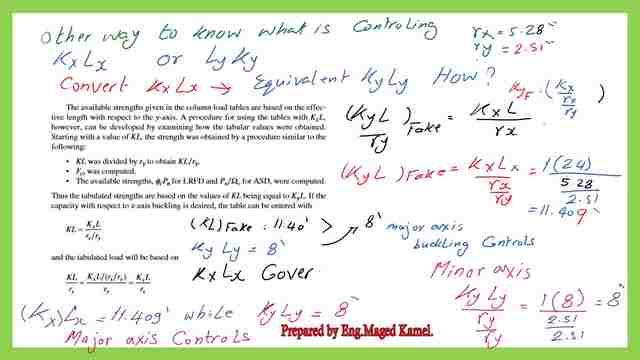

The same result can be obtained after getting the (Ky L/ry) fake for the major axis value=kx*Lx/rx, this value to be compared with the Ky*Ly/ry, then KyLy/ry fake=1*24/(5.28/2.51=11.409′, For (Kl)fake/ry=11.409*12/2.51=54.55, which is the original Kx*lx/rxزThis is a mini-map, for how to covert the buckling (KL)x about the major axis to a fake value (Kl)y, used to compare with the original(KL)y about the minor axis to decide what is the controlling factor for buckling .kxlx/rxز
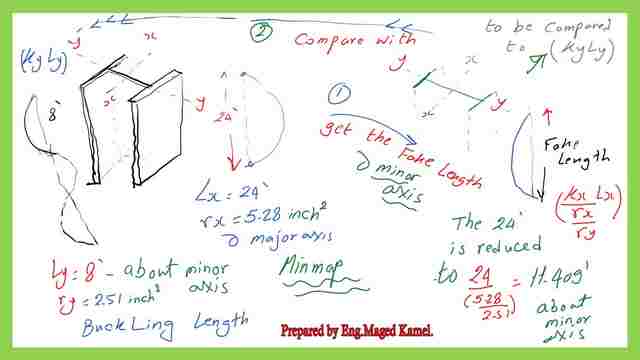

Comparing the maximum value of KL/r with the limiting value, we will find that KL/r at the major direction, which is 54.55, which is the same value of kx*lx/rx.
The maximum value which is equal to 54.55 will be compared to the limiting value of 4.71*sqrt(E/fy). the limiting value for fy equals 50 ksi and e equals 29000ksi can be found to be equal to 113.43. Our column is not in the elastic region. hence the critical stress Fcr to be estimated from the relation Fcr=0.658^(Fy/Fe)*Fy. To estimate the value of Fcr we need to estimate the Euler’s stress based on the buckling in the x- direction as shown in the next slide image.


LRFD and ASD values for Critical stress for solved problem 4-9-General equation.
Once we have estimated the Euler stress, we will proceed to estimate the critical stress value, plug in all the data, and get the value of Fcr=40.23 KSi.
The LRFD value of nominal compressive stress can be estimated by multiplying phi*Fcr * area. The area is 17.00 inch2. The Phi value is 0.90. We can get the value of 616 kips for the LRFD design.
The ASD value of nominal compressive stress can be estimated by multiplying (1/omega)*Fcr * area. The area is 17.00 inch2. The (1/omega) value is (1/1.67). We can get the value of 410 kips for the ASD design. The factored LRFD & ASDF values for Fcr can be computed from the general equation, these values are shown in the next image.
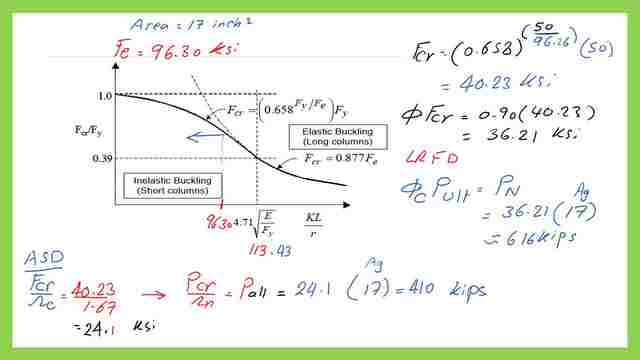

LRFD and ASD values for Critical stress for solved problem 4-9-Table 4-22.
We can use Table 4-22, from the construction manual -14, and specification AISC 360-10. The table will give the value of the critical stress for both LRFD and ASD designs. The controlling parameter is based on the (Kl/r) in the y-direction.
We have estimated the controlling value as equal to 54.44,ky*Ly/ry, we use this value from the left side and intersect it with the column for the value of yield stress Fy=50 ksi . The factored LRFD & ASDF values for Fcr can be computed from Table 4-22, this time, these values are shown in the next image and are matching with the ones obtained from the general equation.
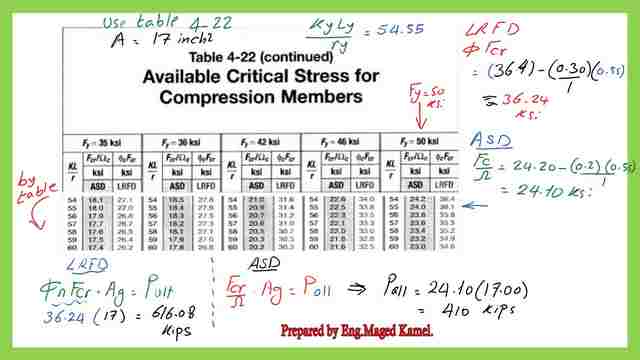

Solve using Table 4-14 in Construction Manual 15.
The expression of (K*l/r) is replaced by the expression of Lc/r. For K*L=lc. Lcx=K*Lrx and similarly lcy=K*ly.
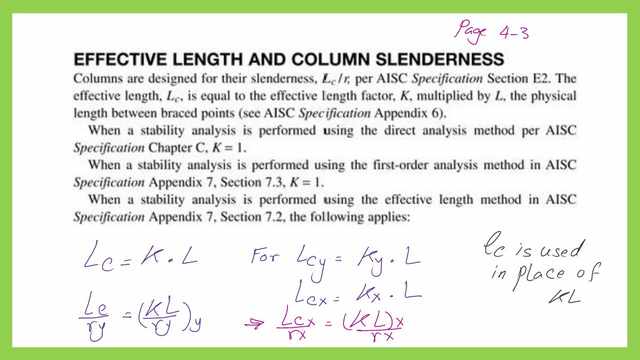

From Construction Manual -15, Table 4-22 was replaced by Table 4-14, in which the expression of Kl/r is considered as Lc/r. from our estimation (k*l/r)x is equal to Lcx/r=54.22, while (k*l/r)y is equal to Lcy/r=38.25. We will select the bigger value which is LCx/r=54.22 and then we will get the value of phi*Fcr =36.24 ksi. The value of phi*Fcr*A=619 kips. Please refer to the next slide image.


From Lc/r equals 55, we can find the ASD value of (Ω*Fcr) is equal to 24.10 ksi, we multiply by the area then the ASD value equals Pn/Ω =410 kips. please refer to the next slide image for more details
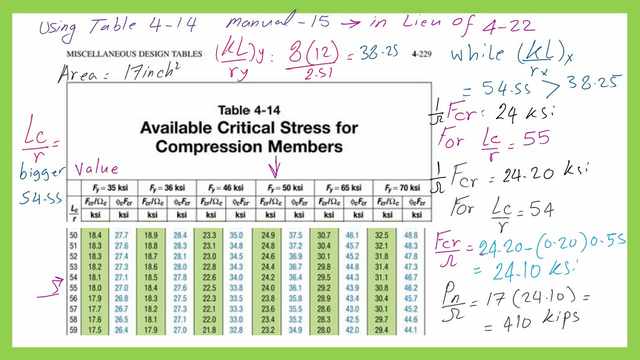

This is the next post, the Alignment chart for columns.
This is a link to an important resource, Concentrically Loaded Compression Members.

